2020 Bordeaux: bottled classic

By Panos Kakaviatos for wine-chronicles.com
21 October 2023
Dear Readers,
It has been a while, but after buying a new apartment with renovation work, prioritizing articles in magazines for which I am paid, and work from my day job at the Council of Europe, I took a hiatus from this website. Also because WordPress sucks. Seriously, there is always a bug, so I am looking into other website options.
But here we go: some detailed reviews of the 2020 vintage from Bordeaux in bottle, which I feel overall is the most classical (recent) vintage since 2016, in a modern context of course. We are not back in the 1980s. But 2020 has a less solar feel than 2019, 2018 or 2022 for that matter. Do not buy the hype about 2021 being a return to classics: that is a euphemism for an average vintage, which was too often too expensive en primeur!
Having been in Bordeaux to taste the 2022s from barrel, with even crazier opening prices for many brands, readers would be wise to compare opening prices for 2022 with 2020 in bottle – and not 2021, which is not nearly at the level of either vintage. Speaking of which, I experienced a comparison of several recent vintages at Château Phélan Ségur in Saint Estèphe. While 2018 can captivate for extreme ripeness (and better balance than 2015), 2020 is overall more refined, subtle and elegant. As you have already heard from all them official critics and promoters, many 2022s are indeed extraordinary, as tasted from barrel, with some comparing the vintage to 1947 or 1949 in terms of number of days between April and September over 30°C. But who knows in the long run? Club Oenologique published my initial summary on the 2022 from barrel here.
But the relative quiet power of 2020 wins for seekers of Bordeaux classicism in recent vintages. In a recent 20-vintage vertical at Clos Fourtet in Saint Emilion, to take but one example, I found 2020 more classical than either 2022, 2019, 2018. Indeed it comes close to the sheer excellence of the 2016, to which I gave a rare 100 point score! Premium subscribers to Decanter can read about it, published on 6 October, here. And 2020 classicism is not limited to any specific region: When I took part in a tasting this past May in Washington D.C., Emeline Borie of the excellent Château Grand Puy Lacoste in Pauillac told me that among the 2018, 2019 and 2020 vintages, she prefers the latter as more classical, too. Furthemore, all the 2020s I tasted at that event (linked to the Heart’s Delight) were at least very good to rather sublime, like the Château Léoville Poyferré.

Emeline Borie of Château Grand Puy Lacoste at a Heart’s Delight tasting at the WineLAIR in the Ritz Carlton Hotel
Lunching at Château Montrose late last year with managing director Pierre Graffeuille, he served the 2016 and 2005 vintages, apt for assessing the 2020, which we had tasted from this venerable Second Growth. “You get the structure of those (earlier) great vintages,” he remarked. “And you have all the advantages of a solar vintage but not the disadvantages”, added technical director Vincent Decup. Indeed, the 2020 Phélan Ségur, which I also liked very much, also had some 2016 and 2005 about it, but with more charm.

Real Classical McCoy
Although the vintage at the time had the driest summer since 1959 (2022 sets the new record), with small and thick-skinned grapes and high alcohol potential and low acidities, “we had cooler nights” as compared to 2018 to account for the freshness and wonderful sap in the wines, despite the hot and dry summer”, explained Vincent Millet at neighboring Saint Estèphe estate Château Calon Ségur.
Comparing 2019 and 2020
While some 2020s, on the Left Bank especially, lack the immediate charm of the 2019s and cannot match the unbridled, nearly New World showiness of the 2018s, many convey depth and concentration with refined classicism: one vineyard director told me that the 2020s “have such precision, it is diabolical”. Why classical? Most Left Bank 2020s have lower alcohol balances compared to 2019 and 2018. Indeed, after having tasted in February this year through numerous Saint Estèphe wines in both 2020 and 2019 for an article that Decanter Magazine published this summer, my sense of the 2020 vintage was triple verified. 2019, which has been compared as more classical to the 2018, comes across far more solar than 2020. Take for example Château Montrose. While balanced in both vintages, the 2020 has about one degree less alcohol than the 2019. Sure, both are “balanced”, but the lower alcohol balance in 2020, I prefer.
Having said that, alcohol levels can be high on the Right Bank, such as the 15.5% encountered at Château Clinet 2020 in Pomerol, which pursues a more powerful style among Pomerols in any case. But balancing acidity makes many compelling wines. From barrel, I felt that the very best came from prime spots in Pomerol and Saint Emilion. From bottle, the Médoc reflects much success.
Trilogy Tasting – yet more proof of 2020 classicism
A trilogy tasting across different price points came in handy at the recently revamped Moulis estate Château Mauvesin Barton, in the appellation of Moulis, where I also tasted the Saint Julien Third Growth Château Langoa-Barton and Second Growth Château Léoville Barton, with estate communications director Magali Pourquie. The 2020 Léoville Barton, for example, clocks in at 13.5% alcohol, lower than the other two vintages, each with 14%. With the greatest percentage of Cabernet Sauvignon, at 85.5% (the 2019 has 84% and the 2018 82%), the 2020 exudes impressive notes of pencil lead and graphite, in a precise palate with underlying power. In many ways, quite a “classic” expression in the positive sense of the word. The 2019 shares that precision and linearity and with the benefit of one more year of aging seems more complete today. The 2018 is the most open of all, as one might expect, with roasted red and black fruit impressions, veritable mid palate succulence and lovely balance with underlying structure for the long haul.
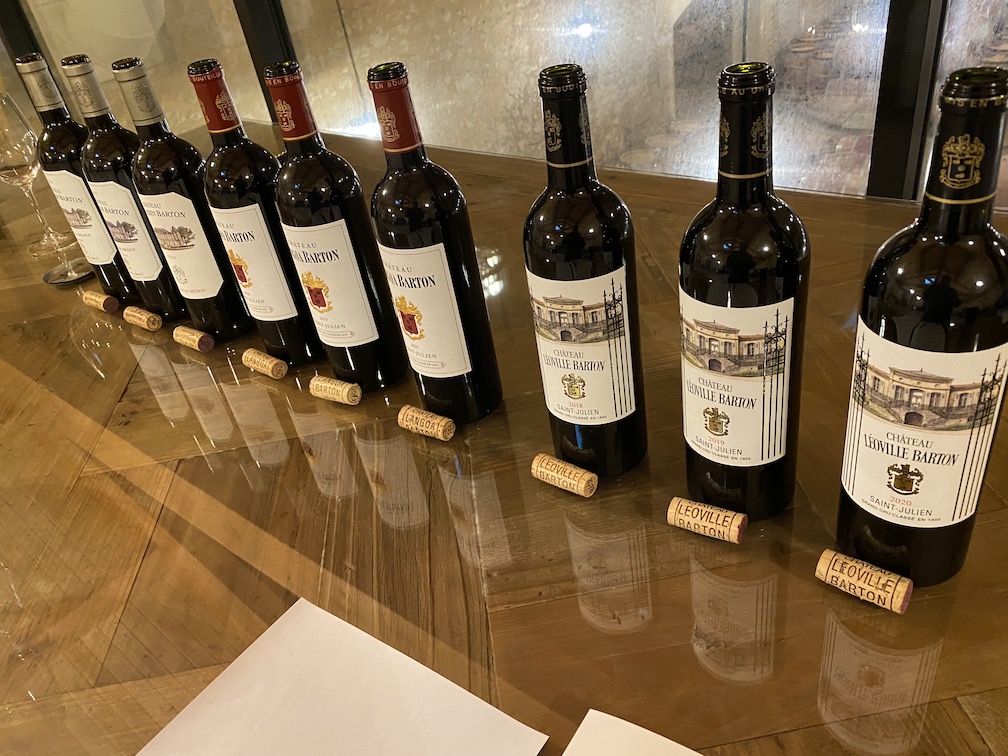
Only one of the three truly “solar”
Château Langoa Barton meanwhile has been coming on strong in recent vintages, and this trio proves no exception, with the 2020 more opulent than the Léoville Barton, as its 38% Merlot shows a creamier touch. I adored the 2019 Langoa, so smooth and precise, with more pristine elegance than the 2020 in this case (a bit of an exception to the 2019-2020 comparison), perhaps due to the greater proportion of Cabernet Sauvignon (only 26% Merlot in the 2019 blend). Meanwhile, the 2018 shows both density and succulence, albeit not quite as much finesse as either the 2019 or the 2020.
As for Château Mauvesin Barton in Moulis, the wines are performing better than ever since Mélanie Barton has taken a solid lead in directing operations. Aged in about one-third new oak, the wines have over 50% Merlot, with the 2019 clocking in at 64% Merlot. Among the three, the 2020 seems the most successful, marrying the excellent depth of the 2018 with the linear precision of the 2019. Indeed, it has the most Cabernet Sauvignon in the blend (59%) and the lowest alcohol balance, clocking in at 12.65% as opposed to the 13% in the 2019 and the 13.5% in 2018.
From Bordeaux to New York
In addition to tastings in Bordeaux in late 2022, at estates and in group settings, from lower-priced Cru Bourgeois to high end estates across appellations, the mood was positive at the Cipriani lounge in New York City in January this year, where the Union des Grands Crus de Bordeaux hosted hundreds of tasters packed into expansive space. Not too long ago, this would have been a super Covid spreader… Among hundreds of humble Bordeaux AOC and Cru Bourgeois Médoc AOC wines, thanks to Planet Bordeaux and the Alliance des Cru Bourgeois, many did not make the cut of 90 points, but plenty enough to reassure that 2020 is very good at lower price points, too.

Quite the ambiance: Tasting 2020s from bottle in New York City, January 2023
Barrel aging, rounded tannins
Barrel aging has rounded noticeable tannins encountered from barrel in the Médoc. You want Pauillac power, with unmistakable notes of pencil lead and cassis? You find that in spades: from Château Pedesclaux to Château Mouton Rothschild that clocks in at well under 13% alcohol. Mouton Rothschild director Jean-Emmanuel Danjoy says that 2020 has a “bit more depth” than the 2019, as did other commentators. Saint Estèphe includes a wine of the vintage in Château Cos d’Estournel: seamless opulence and power, seashell freshness, endless finish. And a cool special label marking the estate’s 200th anniversary and 20th anniversary of current owner, Michel Reybier, at the head of this second classified growth.
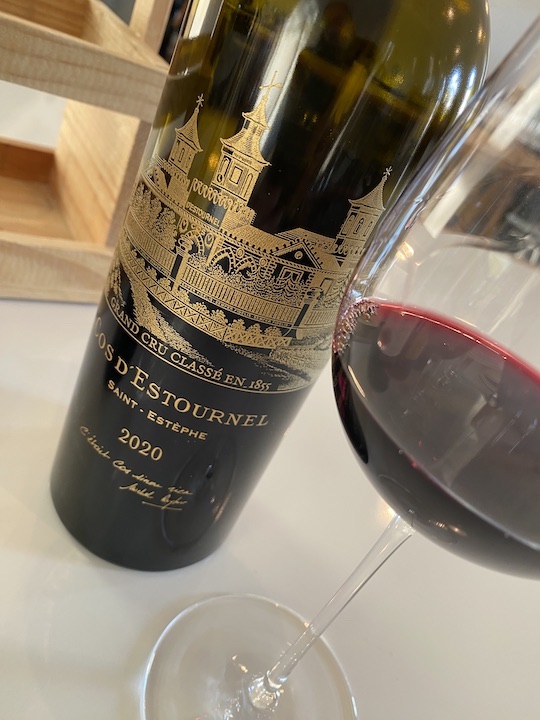
A wine of the vintage
Further south in the Médoc, one encounters floral elegance and underlying power at Château Brane Cantenac in Margaux to spherical, First Growth like breed at Château Gruaud Larose in Saint Julien. Many non-classified wines I tasted were very good to excellent, especially Château Sociando Mallet (AOC Haut Médoc) and Château Poujeaux (AOC Moulis), but also several currently classified Cru Bourgeois.
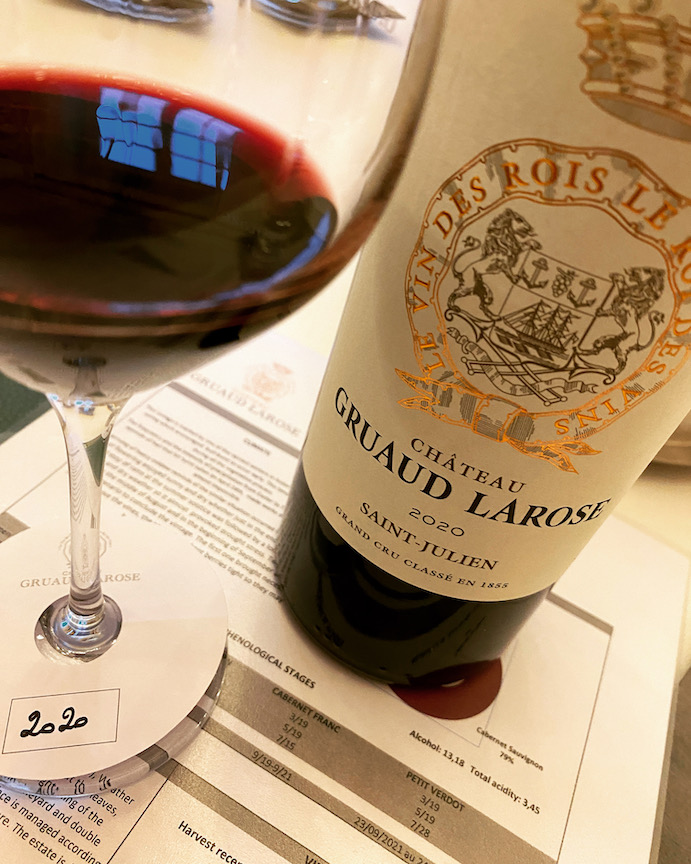
Veritably kingly Gruaud in 2020
Right Bank appeal, also confirmed
The Merlots from cooler clay and limestone soils make the Right Bank especially captivating. Catching up with a group of tasters at the negociant CVGB at Château Belgrave, I spoke to Hans Martin Gesellmann, portfolio manager for Kracher Fine Wine in Austria. While he calls 2020 an “excellent vintage” for both the Right and Left Banks, his wine of the vintage is Château Vieux Château Certan in Pomerol. As in the Médoc, buyers find quality also from economical brands. Take for example Château Beauregard in Pomerol, which exudes bright fruit and impressive structure. Same goes for Saint Emilion.
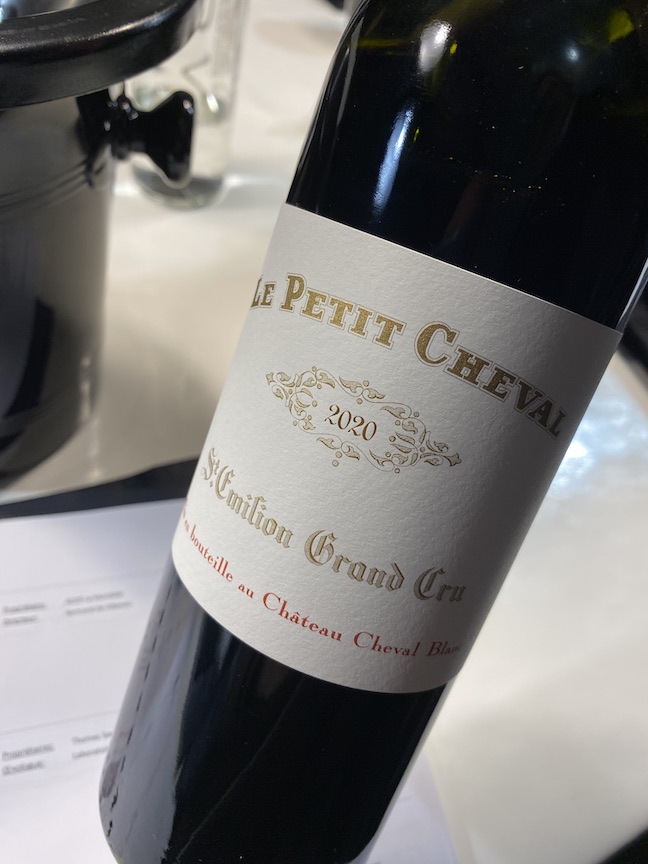
Cheval Blanc is great, but the second wine puts other first wines in the back seat.
The second wine of Cheval Blanc, Petit Cheval, especially impressed friend and author Jane Anson and myself in a marathon tasting of Saint Emilions at the Bordeaux negociant Joanne. As for pricier brands in Saint Emilion, we went from one great wine to the next at that tasting, including a spectacular Château Larcisse Ducasse, pure in its expression of wet stone and precision. Or, Château Canon, whose floral aromas precede palate density and depth conveyed with cool freshness and a long finish. In New York, I especially liked Clos Fourtet. But as in Pomerol, you find less expensive wines of high quality from Saint Emilion, such as the wet stone elegance and refinement of Château Laroque, which Jane dubbed a “brilliant wine”, to the gorgeously balanced Château Rochebelle with smooth tannins and a long finish.
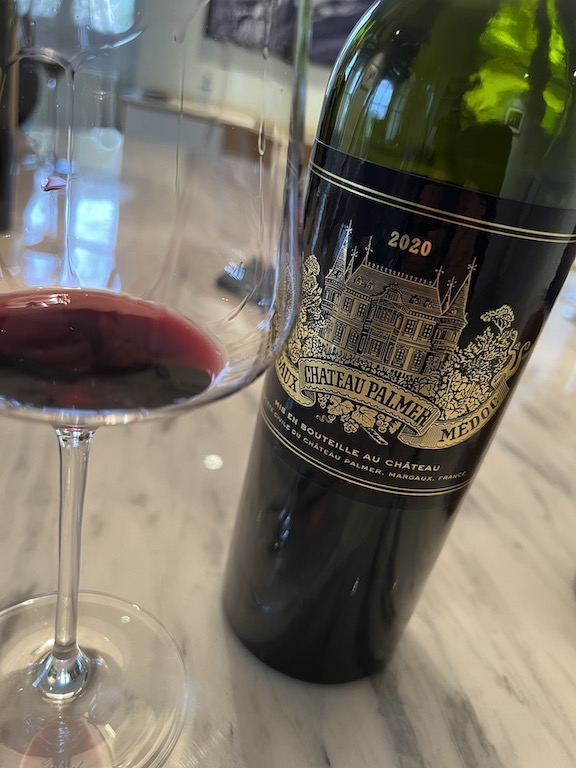
Year in, year out excellence
As with the 2019 vintage, few people assessed the 2020 vintage from barrel because of COVID lockdowns and limitations, but by late last year, tasters came back in force. Château Palmer director Thomas Duroux commented: “I don’t remember seeing so many people at the same time to taste the most recent bottled vintage.” London based merchant Bordeaux Index had confirmed earlier this year that 2020 is selling better than both 2017 and the “challenging 2021”, albeit “a long way from the heady days of the 2016 and 2018 campaigns,” director Matthew O’Connell wrote in an email. In any case, I much prefer the balance of Palmer of 2020 to the 2022.
Solid whites
As for dry whites, comparisons are being drawn between 2021, which some critics billed as great. Perhaps its image was accentuated from the under-performing reds. At Château Margaux, comparing the (100% Sauvignon Blanc) Pavillon Blanc 2021 and 2020, neither was clearly better. The 2021 conveyed higher acidity, but also less charm than the 2020, which displays superior body and dry extract.
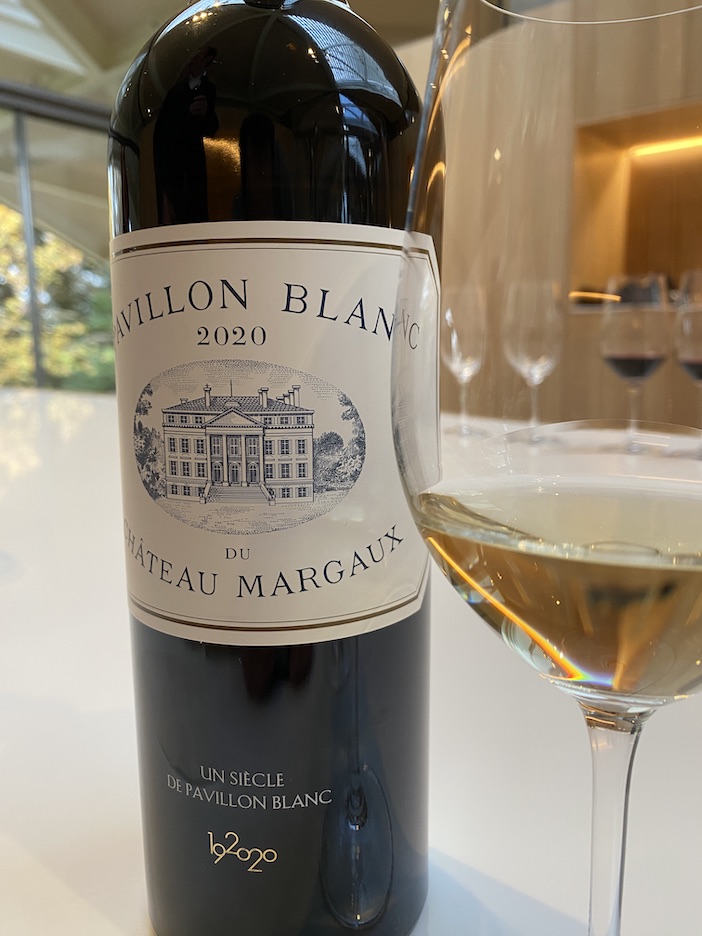
As with the reds, the very best 2020 whites come from vines growing in cooler microclimates and/or soils. Take for example the superb Domaine de Chevalier, which benefits from a cooler microclimate, or the limestone subsoil at Château Couhins-Lurton Blanc, another classified Graves from the Pessac-Léognan appellation.

Economical option for very good dry 2020
The 2021 is certainly fleshy, clocking in at 13.5% alcohol, but also balanced by vibrant acidity and wet stone purity, topped off by juicy apricot and brisk lime aspects. By comparison, some 2021 whites come off leaner and less fun. In short, while the whites of 2020 do not constitute a great vintage akin to 2014, many are very good.
With many thanks to individual estates for letting me taste their wines and to negociants Joanne and the CVBG for inviting me to their organised tastings that gathered so many estates for much convenience. And thanks to the UGCB, Les Crus Bourgeois, Le Conseil de Grands Crus Classés du 1855 and to Planet Bordeaux.
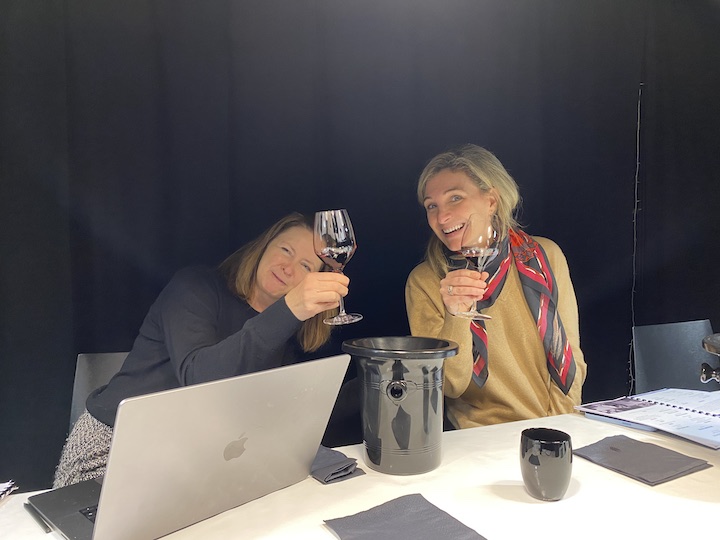
With Jane Anson (at left) and Laure de Bronac, happy to taste Right Bank 2020s at Joanne.
I did not get to as many estates as I would have liked, but you can get a good picture of the vintage from scores of wines picked among favorites. As usual, if in bold, I liked particularly. If red and bold, even more. And if underlined, too, a nirvana wine of the vintage. If an asterisk*? A truly special wine. Notes for red Graves and Pomerol coming later.
Left Bank: Dry Whites – Haut Médoc / Moulis / Listrac – Margaux – Saint Julien – Pauillac – Saint Estèphe
Right Bank: Saint Emilion –
Médoc
Château Beauvillage (Cru Bourgeois) – A blend of 55% Merlot and 45% Cabernet Sauvignon coming from a northern part of the Médoc, is smooth and ripe, with a sunny yet firm disposition. Merlot like chocolate but not too rich, which would be cloying. It lacks the power one would expect from a northern Médoc wine, but it has friendly charm. 14% alcohol. 89
Château Patache d’Aux (Cru Bourgeois) – A brand with a horse-driven carriage logo has been long known at French supermarkets, and in some parts of the U.S. The word “patache” means a type of stagecoach. Long considered a “cru bourgeois” since the original classification of 1932, this Merlot-Cabernet Sauvignon blend clocks in at 13% alcohol, and while it exudes a slightly steely aspect, the mid-palate reassures with power. Well north of the Saint Estèphe appellation, and a five-minute drive due northwest from Château Beauvillage, the wine likewise benefits from a cooler climate that works well in solar vintages like 2020. Give it another year or two to tame the tannins. 90
Château Preuillac (Cru Bourgeois Supérieur) – Further south, closer to the Saint Estèphe appellation, this estate benefits clearly from its proximity to the Gironde Estuary, long been recognized as an excellent Médoc wine. The 2020 doesn’t disappoint with tannic grip. But it also is imbued with ripe fruit and subtle spice. Smooth, refined and with a pleasing finish. Sure, some raw tannin, but it has more refinement than other Cru Bourgeois estates tasted by comparison. 90+
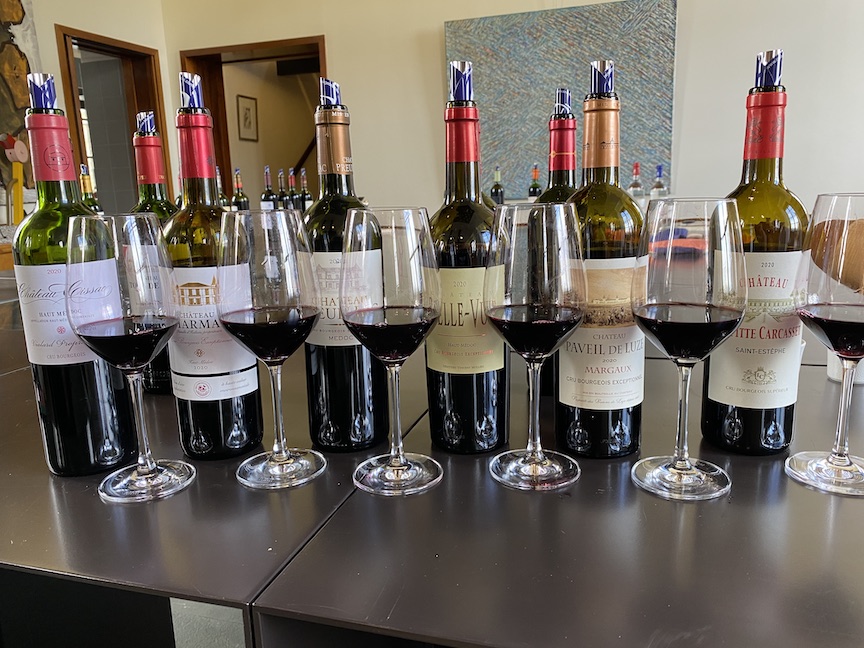
Among successful Cru Bourgeois tasted late last year from bottle
Château d’Arcins (Cru Bourgeois) – A popular selection at the Nicolas wine shop chain in France, and widely available in the U.S. and in the UK, this has a friendly approach, almost sweet with notes of toasty oak. Very pleasurable and sumptuous for its pedigree although Old School lovers of firm, powerful tannins may not like it as much. A popular by-glass selection for a wine bar. 13% alcohol. 90
Château d’Agassac (Cru Bourgeois Exceptionnel) – Has power and smoothness, par for the course for this consistently good estate. The finish is denoted by some austerity but in a good sense, auguring well for aging. No bitterness, but not overly sweet either. Fine balance. Entering the upper Cru Bourgeois echelons here. 91
Château Beaumont (Cru Bourgeois Supérieur) – Excellent focus and sumptuousness that is not forced, but natural, with elements cohesive in their expression. The aromas are not reflecting obvious oak toast, for example, but rather ripe fruit, and a hint of vanilla without cloying aspects. The palate is smooth, rich and yet disciplined with tannic structure. While not exuding any “Old School” rawness, this wine provides pleasure and depth. A bit more sumptuous than the Preuillac, so a slight preference for me. 91+
Château Belle-Vue (Cru Bourgeois Exceptionnel) – So far, this wine conveys the most density of all tasted, and for that alone, it ranks highly. A sumptuous nose of ripe dark and red fruits mingling with some oak derived aspects presages a broad yet disciplined palate that approaches cru classé levels. Indeed, the estate is but a three-minute drive from Château Giscours in Margaux. Long finish, fine wine. 92+
Château Cantemerle (Cru Classé) – I prefer this to the La Tour Carnet, as more subtle and elegant, but Sociando Mallet is the Haut Médoc to buy in 2020 after trying both side-by-side. However, I like this wine’s juicy Saint Julien-like mid palate density, with soft tannins over a powerful structure. Nice job! 93
Château Cambon La Pelouse (Cru Bourgeois Exceptionnel) – While very good, it lacks the subtle power and depth of the Belle-Vue, which I had sampled just before at a tasting organized by the Alliance de Crus Bourgeois. I like the spice, but there is a sense of protruding elements, while Belle-Vue is more spherical and seamless. Give it a few years to come together however. 13% alcohol. 90
Château Charmail (Cru Bourgeois Exceptionnel) – Heading further north, where sunny vintages do better, the wine exhibits fruit purity and pencil lead Médoc definition, smooth and with a long finish. A subtle wine that will grace any gastronomically minded table. Just as good as Belle-Vue. 13.5% alcohol. The wine reminds me of the precision of Cissac, but with more opulence. 92
Château Cissac (Cru Bourgeois Supérieur) – Situated in the northern Médoc, between Pauillac and Saint Estèphe, this estate certainly “sees” the river, and benefits from excellent ripeness of the 75% Cabernet Sauvignon (with 20% Merlot and 5% Petit Verdot completing the blend). A lead pencil nose screams Haut Médoc, and the taster is enchanted by fruit purity, frank freshness and a long finish. Truly, this reflects the success of 2020, and I like how it is not so obviously sumptuous, but reflecting an Older School Médoc approach, albeit smooth. I want steak now. 13% alcohol. 92
Château La Lagune (Cru Classé) – The very best of the Haut Médocs, along with Sociando Mallet, this blend of 65% Cabernet Sauvignon, 30% Merlot and 5% Petit Verdot clocking in at 14% alcohol impresses with smooth tannin and nuanced expressions of pencil lead and cassis, very classical and refined, leading to a long finish. 94+
Château Lanessan – Excellent purity of fruit and refinement. Tasted at CVBG, just after Gruaud Larose, the tannins are not quite as refined, with a clear distinction between “classified” and not. However, for the price, a very good bottle. Indeed, this blend of 52% Cabernet, 43% Merlot and 5% Petit Verdot has chipper red (and ripe) fruit, while coming off truly classical, with some high-toned notes. At least matching if not better than all officially named Cru Bourgeois I have tasted. 93
Château Paloumey (Cru Bourgeois Supérieur) – Certified organic, which could help sales because no one in the U.S. knows what “HVE” means, this wine is crafted from vines further south in the appellation, with more richness compared to cooler northern areas. Clocking in at 14% it has balance and friendliness. It lacks the focus and precision of, say, Cissac, but I suspect improvement in next couple of years. 89
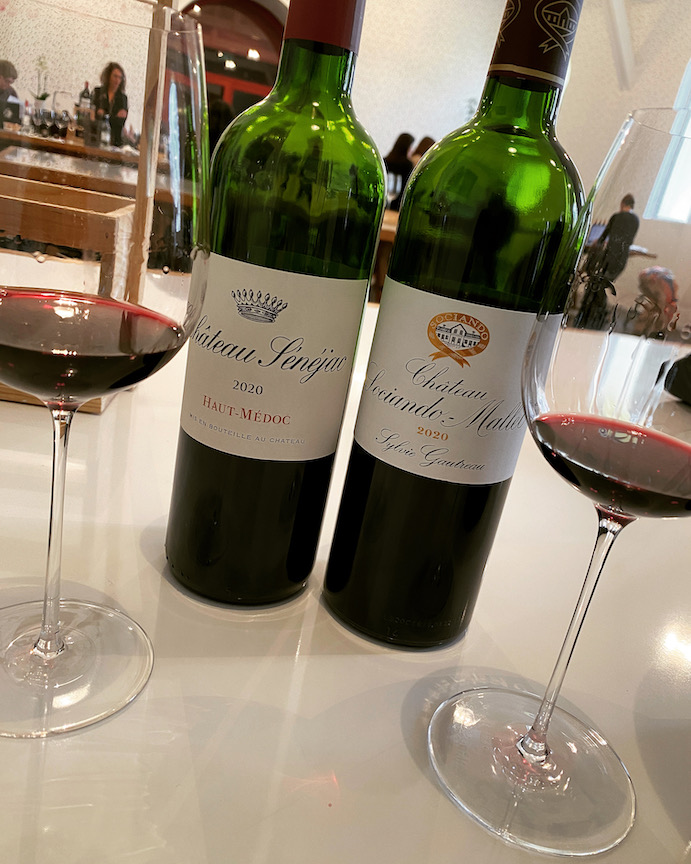
Château Sénéjac – This has depth and power, quite a smooth palate. Located further inland from Belle-Vue, perhaps with cooler clay, the wine exudes depth and power, somewhat similar to the Belle-Vue, which I liked for its density at the Cru Bourgeois tasting. 92+
Château Sociando Mallet – Stands out wonderfully, with pristine notes of bright fruit. Better than Sénéjac, tasted just beforehand, proving yet again the strength of this unclassified – shall we say, who cares about class? – estate. When I tasted La Tour Carnet, a classified Haut Médoc, the power was noticeable, but it lacked the refinement of the Sociando. The wine blends 53% Merlot, 46% Cabernet Sauvignon and the rest Cabernet Franc, having aged in 90% new oak for 12 months. Clocks in at just 14% alcohol. Note for 2022, powerful hail struck this estate especially hard, so very little quantity from the 2022 vintage… 94+
Château du Taillan (Cru Bourgeois Exceptionnel) – It is hard not to like this wine’s seashell freshness, even if the tannins are a bit austere from this blend of 85% Merlot and 15% Cabernet Sauvignon. Give it time to come together. Alcohol is 14%. 90
Listrac
Château Clarke – One of my favorite Listrac wines, year-in and year-out, it doesn’t disappoint in 2020, and I like its tannic edge, despite welcoming fruit-driven Merlot aromas and flavors (70% Merlot in the blend). A bit of seashell freshness on the finish lends complexity and freshness, and the structure is such that this would be best in five or even 10 years. 91+
Château Fonreaud (Cru Bourgeois Supérieur) – Frank and fun, with smooth tannin. Hard not to like. Doesn’t really stand out, but it is tasty and fun to drink. Beckons more sipping, al 13% alcohol. 90
Château Fourcas Dupré – An excellent Listrac, that outpaces the few others I sampled from 2020. Although conveying a bit of youthful austerity, the seashell freshness and solid mid palate are enticing. The velvet like tannin reassures. 92
Moulis
Château Biston-Brillette (Cru Bourgeois Supérieur) – Purchased earlier this year by Château Chasse-Spleen, this can be an under the radar wine that did well in 2020. Tasted thanks to the Alliance of Cru Bourgeois, this blend of equal parts Merlot and Cabernet Sauvignon typifies the vintage with subtle expressions of white flower, blackberry and light notes of licorice. At 13.5% alcohol a fine balance. 91
Château Mauvesin-Barton – Tasted on two occasions, it has plenty of finesse and creaminess, pairing the excellent depth of the 2018 with the linear precision of the 2019. Indeed, it has the most Cabernet Sauvignon in the blend (59%) and the lowest alcohol balance, clocking in at 12.65%. What a long road taken to make very good and affordable wines. Bravo to Mélanie Barton! 92
Château Maucaillou – Fine bright red fruit and ripe tannins. 91
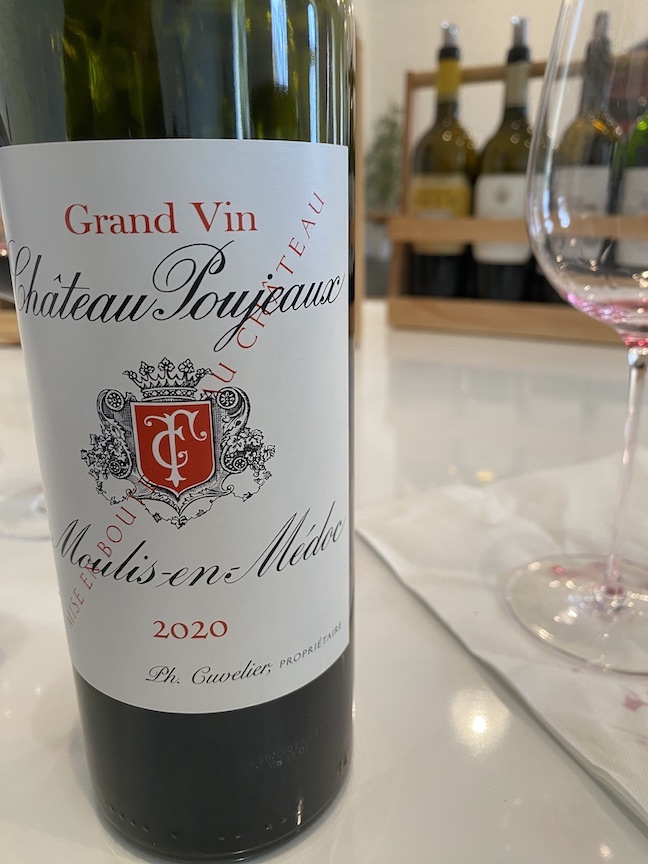
Setting the Moulis standard.
Château Poujeaux – This wine has power, depth and smooth tannin. Blending 54% Cabernet Sauvignon, 40% Merlot and 6% Petit Verdot, having aged 12 months in 33% new oak, the wine has a slighty seductive chocolate aspect without being simplistic or over glycerine-y. Over last 10 years, this remains the very best among all the Moulis wines. An example to follow. 13.5% alcohol and a rather high pH of 3.89. 94
Margaux
Alter Ego of Château Palmer – Frank attack but showing an opulent, juicy mid palate. While the length and density are not as impressive as with the grand Palmer, this blend of 50% Cabernet Sauvignon, 46% Merlot and 4% Petit Verdot, clocking in at 13.7% alcohol and with a pH of 3.73 is very successful. A low level of SO2 helps reveal vivid red and black fruit. 94
Château d’Arsac (Cru Bourgeois Exceptionnel) – More focused and indeed one of the very best wines of a tasting organised by the Alliance of Crus Bourgeois, living up to its “exceptional” ranking. Blending over 70% Cabernet and the rest Merlot, a pure expression of lead pencil, with some austerity, but not hard or rustic. Give it three years before opening. 92
Baron de Brane – This second wine of Château Brane Cantenac keeps improving, packing enough substance to pair with 15% new oak aging. The grapes come from the Carabin area, just next to Giscours and from parts of Derrière le Parc. Using Air Pulse since 2019. Fine density here, and it reminds me of the Belle Vue compared to the other Cru Bourgeois tasted the day before in Bordeaux. Nice succulence. 93
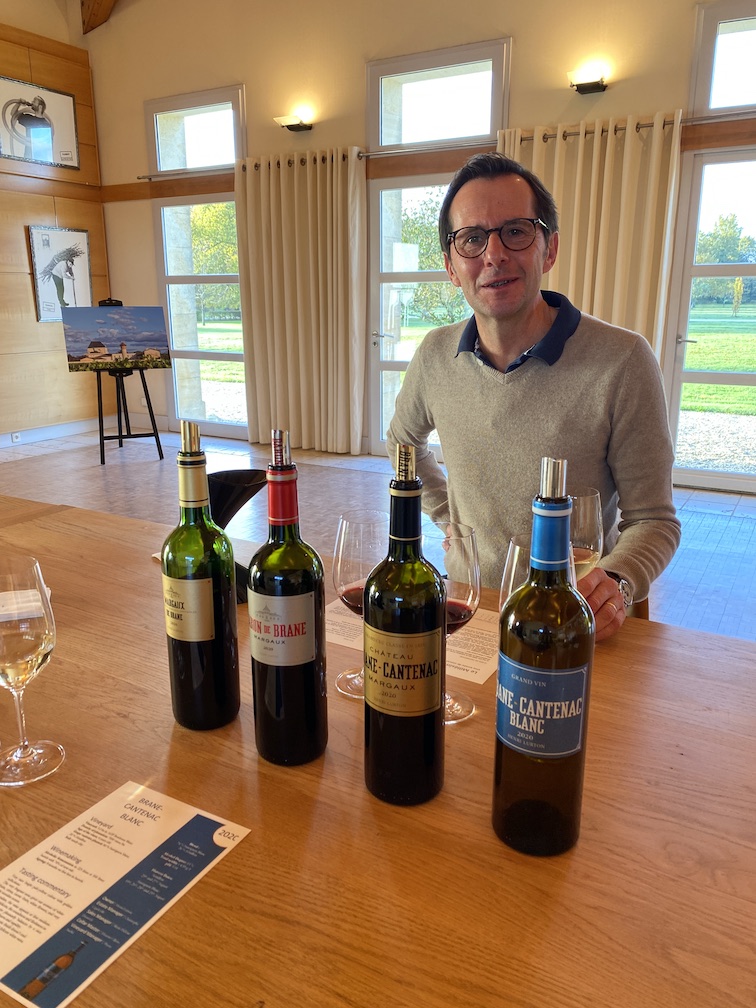
Brane strides to glory in 2020: Tasting with director Christophe Capdeville
Château Brane Cantenac (Cru Classé) * – What vivid floral elegance and subtle power! And tannic finesse. One of the best performances from this estate, which is still undervalued for the quality. You get lead pencil Cabernet focus. The wine blends 70% Cabernet Sauvignon with 26% Merlot, 2% Cabernet Franc and 1% each of Petit Verdot and Carmenère. Since 2019, only grapes grown from the plateau are used to craft the first wine. And it shows. The team have increased aging to 100% new oak, working with different types/toastings and seasoning of oak. A spherical wine that counts among the top tier of 2020. 13.7% alcohol. Similar notes in Bordeaux and in New York. 97
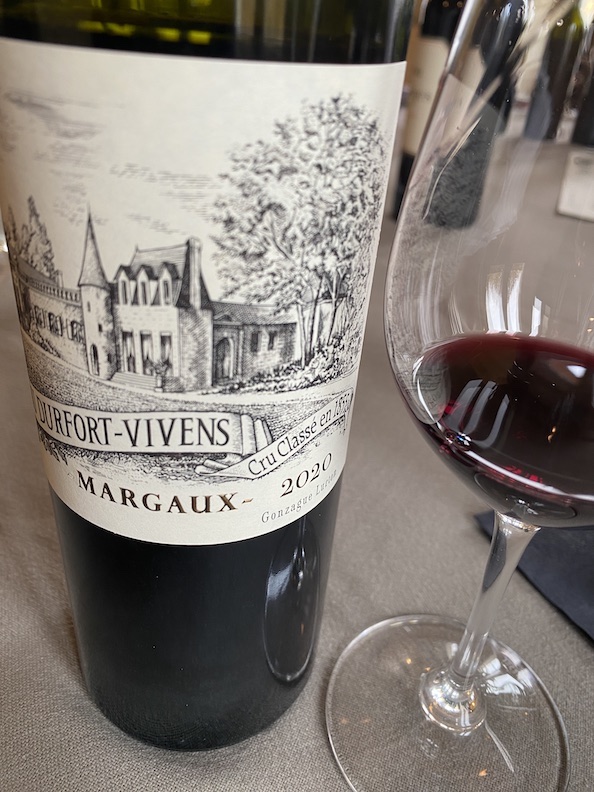
Yet another excellent Left Bank 2020
Château Durfort-Vivens (Cru Classé) – The 2020 reminds me a bit of the 2011, with noticeable tannic linearity, but with greater refinement reflected in peony floral notes, graphite and wet stone. I like the subtle density, as opposed to thickness. And the acidity is pleasantly salivating from this blend of 88% Cabernet Sauvignon and 12% Merlot, having aged in 70% new oak and 30% amphorae. Nicely balanced wine at 13.5% alcohol with a pH of 3.65. 95
Château Ferrière (Cru Classé) – Bright and high toned, a much better wine than La Gurgue, tasted before. Gonzague Lurton says that 2019 was a more “exuberant” vintage than 2020, and 2020 more “classic” – an oft heard refrain. I like the charm and florality but at this early stage, you notice more the structure. The wine blends 68% Cabernet Sauvignon, 27% Merlot, 3% Petit Verdot and 2% Cabernet Franc. Give it time in bottle and crack open at the 10 year mark. 93

Bravo to Giscours in 2020: succulence for a great price
Château Giscours (Cru Classé) – Not surprisingly, this estate, which has been on a roll in recent years, offers beautiful, refined, floral elegance, with power. Another grand success in 2020. If I want to be a bit picky, it does have some headiness (perhaps the higher octane 44% Merlot in the blend?) as compared to the top Margaux of the vintage, which include Brane Cantenac, but Giscours (about 13.5% alcohol) certainly comes across as a (delicious) crowd pleaser – and quite a value. Tasted twice, consistently pleasurable. 95
Château d’Issan (Cru Classé) – Lovely balance between power and sweetness. The wet stone aspect appeals thoroughly, making this among the very best in Margaux these days. Pristine graphite but also succulent wine, this blend of 55% Cabernet Sauvignon, 39% Merlot, 3% Cabernet Franc, 2% Petit Verdot and a smidgeon of Malbec! It is the first vintage to integrate vines acquired from Château Pontac Lynch, adding extra dimension to the profile. The 2020 exhibits opulence and depth, finely framed by acidity and bright ripe fruit. While the 2019 is more exuberant and expressive, the somewhat tighter and more straightforward 2020 requires more aging in the cellar to come together, drawing yet more comparisons with 2016 and 2005, as I had encountered at Château Montrose. Just under 13.5% alcohol. 96
Château Kirwan (Cru Classé) – Made from a blend of Cabernet Sauvignon (51%), Cabernet Franc (28%), Merlot (14%) and Petit Verdot (7%), this estates comes into its own in 2020, with subtle power, precision, sweetness but not cloying, hanks to the deft touch of director Philippe Delfaut. I prefer the wet stone freshness from Du Tertre, but Kirwan comes in the same vein, albeit with a certain Pauillac style virility but never heavy handed. Excellent wine, and yet another one to buy because prices remain afforable. 93+
Château Labegorce – This has iodine freshness and is quite refined! I like the Margaux elegance here. Very pure and very nuanced. Bravo, love the seashell aspects that are matched by substance, and yet another great deal for consumers. 93
Château Margaux (Cru Classé)* – Clocking in at 13.5% alcohol, blending 89% Cabernet Sauvignon, 8% Merlot, 2% Petit Verdot and 1% Cabernet Franc, I love the orange rind aromatic freshness, with dark fruit, plum and spice, almost like Christmas. The palate is smooth and refined, reflecting the classicism of the 2020 vintage, after having aged 22 months in 100% new oak (bottling in July). As with Palmer, tasted the same day, this First Growth conveys seriousness rather than ostentation. Excellent acidity lends freshness, for an overall frank and refined expression, with subtle, nearly Pauillac-like grip, even if it lacks the power of, say, Mouton. 98
Margaux de Brane – Since 2014, this “third wine” from the Second Growth Brane Cantenac exists, with no barrel aging. Mainly crafted from grapes grown on young vines, it is fresh and with medium body. The 64% Merlot is friendly and the 14.2% alcohol not quite warm but welcoming. Nice! 90+
Château Mongravey (Cru Bourgeois Supérieur) – In Arsac, this estate conveys balance and chipper red fruit. Frank attack and smooth mid palate leading to a clean finish medium. 91
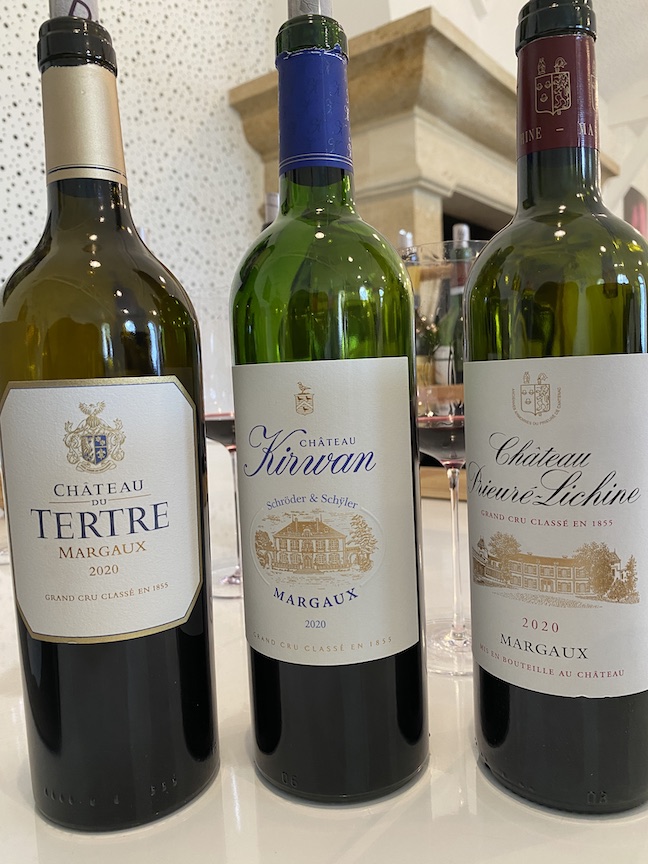
Yet more successful Margaux 2020s, assessed at the CVGB tasting.
Château Palmer (Cru Classé)* – Civilized tannins, refined, but also broad and long. I get the vivid notes of pure fruit, perhaps because of the press wine was top notch (13% used). The tannins are noticeable but refined. Director Thomas Duroux uses the word “Latin” when compared to a somewhat cooler 2019 vintage, but I find the 2020 to be less exuberant than that, expressing mainly cool blue fruit and tobacco leaf elegance, actually quite classic in expression. The blend is not unusual for the estate, at 48% each of Cabernet Sauvignon and Merlot and 4% Petit Verdot. Clocking in at about 13.9% alcohol, Palmer conveys full bodied power but with a velvet touch. 97+
Château Paveil de Luze (Cru Bourgeois Exceptionnel) – Lovely wine, so nicely balanced and refined, but lacks needed depth to be better. Could it be the mechanical harvesting? I think that the estate needs to start hand harvesting to improve selection. 91
Pavillon Rouge of Château Margaux – This blend of 75% Cabernet Sauvignon, 18% Merlot, 5% Petit Verdot and 2% Cabernet Franc, clocking in at 13.6% alcohol, is a top “second wine” from the Médoc. Bottled in the third week of June after having aged in 55% new oak, it comes across rather austere compared to the Alter Ego, tasted the same day, as there is a certain Cabernet edginess to the tannin, that will require aging, I love the pure dark red fruit expressions, along with subtle dark chocolate as well. Sebastien finds it more powerful than the 2016 vintage. 94+
Château Prieuré Lichine (Cru Classé) – I love the forest floor freshness in this quite chipper, lovely wine, seemingly effortless and smooth (ethereal). Made from a blend of Cabernet Sauvignon (65%), Merlot (30%) and Petit Verdot (5%), the Cabernet dominates in a gorgeous pencil lead finish. 93+
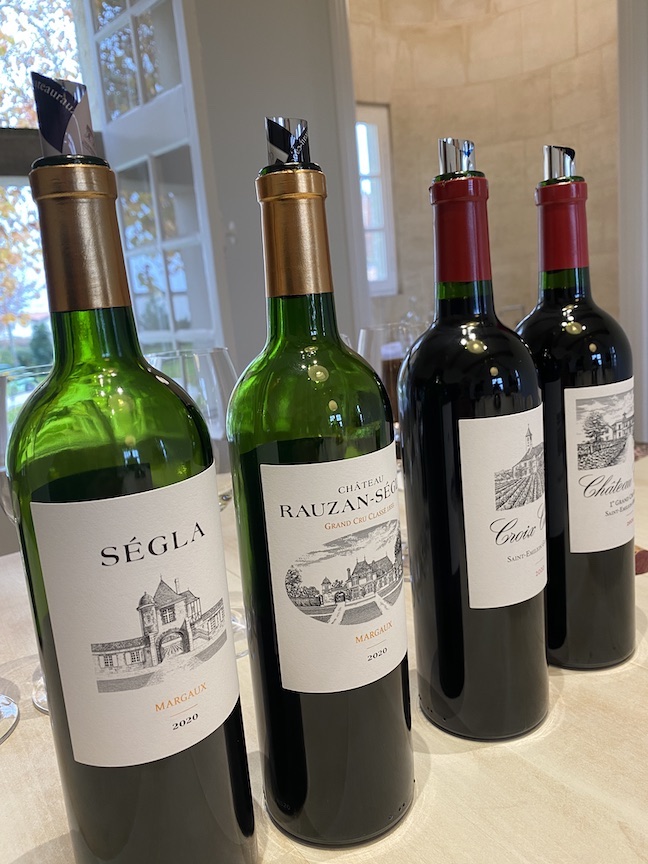
Tasted at the estate.
Château Rauzan-Ségla (Cru Classé) – Cool aroma of spring flowers and ripe plum precede a palate of density and power, delivered in rather contoured and velvety tannin. Some oak present. Plenty of mid palate sap. Interesting how director Nicolas Audebert agrees that the 2020 comes across more classic than the 2018, but not as much classicism as in the 2019, a bit of a contrary perspective. The wine blends 60% Cabernet Sauvignon and 36% Merlot, clocking in at 13.5% alcohol with a pH of 3.74, having aged 18 months in 60% new oak. 96
Château Siran – Another wine worth purchasing for its price-quality ratio delivering both power and grace, with a full bodied expression that appeals. I would give the edge to Labegorce for more refinement and iodine freshness, but still a very good success. 92+
Château du Tertre (Cru Classé) – An estate punching above its weight, tasted twice with same results (in Bordeaux and in New York). Here you have a velvety approach to the appellation, with juicy mid-palate density. While not as diaphanous as the Labegorce, it more than makes up for that with subtle power, leading to a pure, clean finish with excellent lift. Really like this for the price/quality ratio, hence the underline. 95
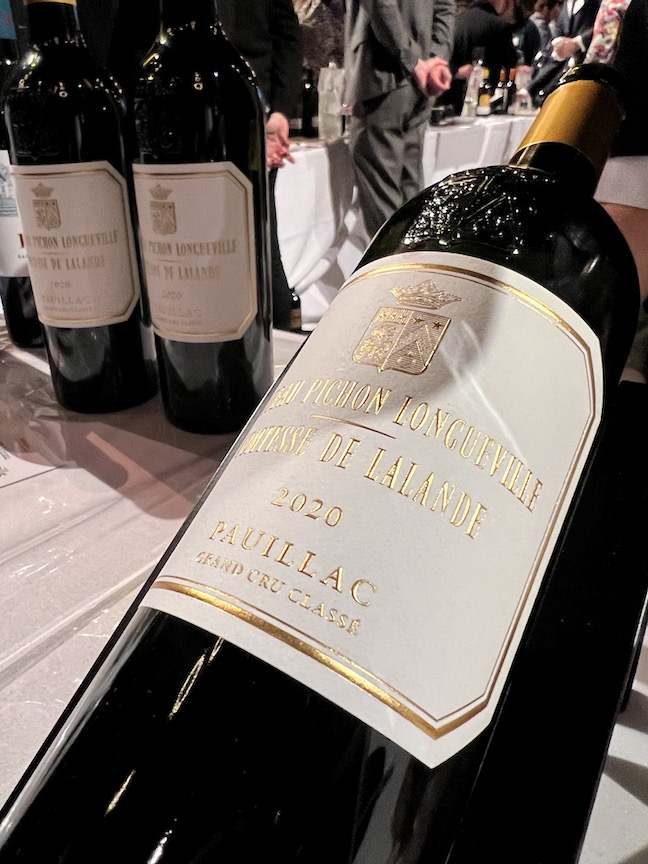
Another year, another great Comtesse
Château d’Armailhac (Cru Classé) – A blend of 59% Cabernet Sauvignon, 30% Merlot, with the rest Cabernet Franc and Petit Verdot, clocking in at 13.3% alcohol, this wine pleases with black fruit ripeness, airy elegance and salinity, all expressed with refined tannin. One of the best ever ! Aged 17 months in barrel with 50% new oak. 93+
Château Batailley (Cru Classé) – Quite lovely, old school to some extent but no rusticity, with notes of new saddle leather, cassis and powerful tannins with polish. This is at least tie for the best Batailley I have had just after bottling, and just about as good as Grand Puy Lacoste at this stage, even if – yes – the tannins can seem just a bit austere on the finish, but give it a few years and it will be truly gorgeous. 95
Château Clerc Milon (Cru Classé) – Cool aromas of blackberry, plum and cassis, I really like the precision of the rather opulent palate, with graphite precision, showing off the 53% Cabernet Sauvignon (53%) – along with Merlot (37%), Cabernet Franc (8%) and Petit Verdot (2%). An excellent integration of 60% new oak, the wine clocks in at 13.19% alcohol with a pH of 3.73. A fine, balanced wine that will reward cellaring. 94
Château Grand Puy Lacoste (Cru Classé) – Pure expression of pencil lead and cassis, so smooth and blissfully cool and polished. While this wine is neither exuberant nor obviously sumptuous, it is classic Pauillac. Just as important: the finish went on and on. The overall impression of this blend of 76% Cabernet Sauvignon and 24% Merlot is of finesse and power. Clocking in at 13.5% alcohol and having aged in 75% new oak, a success indeed. Bravo! 96
Château Haut Bages Libéral (Cru Classé) – While lacking the sheer finesse of Pontet Canet and the impressive depth of Lynch Bages, this fellow Fifth Growth conveys power and substance. The blend of 78% Cabernet Sauvignon and 22% Merlot exudes purity of fruit. Aged in 20% amphorae and 40% new oak. Give it 10 years in your cellar. 93
Château Haut Batailley (Cru Classé) – Tasted at Château Lynch Bages, this blend of 62% Cabernet Sauvignon and 38% Merlot, clocking in at 13.6% alcohol, has fine texture with spice and cocoa. Lush and smooth, but with tannic backbone: it has a rather high tannic index of 81. Changes afoot since the recent acquisition by the Cazes family at Lynch Bages, which purchased some 19 more hectares of vines, nearly doubling the size of the Haut Batailley vineyard to 41 hectares, but the 2020 is made from the original 22 hectares, which are closer to river than those of Château Batailley. Readers can recall that Domaine de Batailley was ranked as a single “Fifth Growth” in the famous 1855 classification of the wines of the Médoc and Sauternes. Only afterwards did it divide into two estates. Aged 14 months in 60% new oak. 94
Château Lynch Bages (Cru Classé) – I like the power from this estate, but also its clarity and definition in expression. A very classic wine blending 60% Cabernet Sauvignon, 31% Merlot, 5% Petit Verdot and 4% Cabernet Franc, it exhibits telltale pencil lead and bright cassis fruit, with impressive depth and length, the tannins taking center stage – a IPT index of 91! – smooth yet pronounced. While it may not be quite as nuanced as the Pontet Canet, tasted earlier on the same day in November in Pauillac, it is great Lynch Bages. As with many other Médoc wines, the wine is lower in alcohol (13.41%) compared to both 2018 and 2019. Bottled at the end of June last year, it is opening more and more, as evidenced by more expressive notes when sampled again in late January this year in New York. High tannic index at 93, aged 18 months in 75% new oak. 96+
Château Mouton Rothschild (Cru Classé) * – A superb wine of subtle depth and power, with at once suave silky and velvety tannin conveying peerless balance. You get the customary opulence, but also exceptional precision and freshness. Blending Cabernet Sauvignon (84%), Merlot (13%), Cabernet Franc (2%) and Petit Verdot (1%), time in glass yields cool, blond tobacco, even notes of menthol, leading to a long finish. For director Jean Emmanuel, it recalls the 2015 “but with more acidity” and I can see that, although I sense a hint of 2016 linearity and 2005 structure. Clocks in at (but) 12.79% alcohol. 99
Château Pedesclaux (Cru Classé) – Blending Cabernet Sauvignon (56%), Merlot (34%) and 5% each of Cabernet Franc and Petit Verdot, this wine is pure pencil lead, very smooth and refined, delivering the tannic goods well with its medium plus body, leading to a long finish. This estate has been on a roll and prices are still reasonable. Do not hesitate. 94
Château Pichon Longueville Baron – Among the top wines tasted in New York, there is no denying the ripe fruit, the spice and pencil lead delivered with the customary Pauillac grip that for which this estate has become famous. A blend of 76% Cabernet Sauvignon and the rest Merlot, the wine also conveys much precision in the somewhat foreboding tannins, leading to a long finish with freshness, refinement and lift. 96+
Château Pichon Longueville Comtesse de Lalande (Cru Classé)* – Tasted twice with similar results, it comes across a bit sweeter nose than the Cos, which I prefer, when assessed in November last year. But among the UGCB wines, as tasted in New York, it proved to be a top wine of the vintage: broad, precise with cool and ripe fruit. What most impresses from this blend of Cabernet Sauvignon (77%), along with Merlot (17%) and Cabernet Franc (6%) is the suble backbone and power buoyed by fragrant floral aromas as well as ripe blackberry and cassis and the expected cedar freshness. A deft integration of the 60% new oak for aging. Indeed, a veritably elegant wine of both delicate balance and density. Another wine of the vintage. 97+
Château Pontet Canet (Cru Classé)* – What lovely iodine freshness from this wine of elegant refinement! The blend of 60% Cabernet Sauvignon, 32% Merlot and 4% each of Cabernet Franc and Petit Verdot exudes subtle opulence and palate breadth, but with precision leading to a long finish. The 55-year-old vines contribute to the depth. Clocks in at 13.5% alcohol, having aged in 50% new oak, 35% amphorae and the rest oak of one year. 97
Saint Estèphe
Château Beau-Site – I love the bright attack leading to somewhat raw tannic power of mostly Cabernet Sauvignon (70% of the blend, with 25% Merlot), well ripened by high elevation (for the Médoc) gravel-dominated terroir. Harmonious cassis, savory creosote with freshness on the long finish comes. “Authentic, terroir driven wine,” remarked Claire Wright of Les Grands Chais de France, who tasted with me. Excellent price/quality ratio. 92+
Château Le Boscq (Cru Bourgeois Exceptionnel) – Lots of punch here, density and power, with a high-toned acidity that shows. I like it quite a bit – and want to go to a barbecue now. Power and supple grip. 92
Château Calon Ségur (Cru Classé)* – I cannot recall a better young Calon Ségur. Tasted twice (at the estate and at the CVGB) with similar results. It is a gorgeous wine, exuding pencil lead finesse and subtle power. I especially adore the wet stone refinement on nose and palate. Already one senses a complex aromatic range, both floral and fruit driven, with silky tannin and precise focus leading to a long finish with lift. A grand success in this blend of 78% Cabernet Sauvignon, 12% Merlot, 9% Cabernet Franc and 1% Petit Verdot clocking in at 13.8% alcohol, with a pH of 3.85. 97
Château Capbern – Revelatory price/quality ratio from one of my favourite St-Estèphes, this blend of 69% Cabernet Sauvignon, 29% Merlot and 1% each of Cabernet Franc and Petit Verdot, clocking in at about 14% alcohol, suavely delivers fine (new) saddle leather, vivid violet, juicy blackberry and tobacco leaf. Smooth and fresh, it has superior depth with noticeable, yet refined (and power-lending) tannins. The high percentage of new oak and Cabernet Sauvignon make for a seamlesss, long finish with sapidité (sap) and désaltérant (thirst quenching) as director Vincent Millet remarked. Another comparison: half a degree less alcohol than the 2018. “We find alcohol levels more within the classical level,” he says. In 2018, you would not think necessarily that the wine came from Saint Estèphe. Enjoy with duck breast. 95
Château Cos d’Estournel (Cru Classé)* – A first-growth level wine. With aristocratic ease this blend of 62% Cabernet Sauvignon and 38% Merlot conveys nimble energy and sneaky sensuality. Pencil lead, white tobacco, cassis, juicy blackberry, cherry and seashell freshness all gorgeously delineated with refined tannin, which provides impressive structure for long-term cellaring. The pH is the highest since 2003, but you get neither heat nor imbalance. Impressive dry extract and rather “normal” alcohol at 13.46% evokes a (positively) classic feel, leading to a subtle yet super long finish. As for tannin levels, the IPT of 80 is not as much as that of the Lynch Bages of 91, but that also explains a sublime subtlety here, too. Aged in 55% new oak, a judicious percentage that makes the tannic expression suaver. Candidate for wine of the vintage. For owner Michel Reybier, the vintage marks 20 years of “passion at the helm” – encased in a uniquely gold coloured engraved bottle with the phrase “C’était Cos sinon rien” – Cos or nothing else. For special occasions and special meals. 99
Château Le Crock (Cru Bourgeois Exceptionnel) – Smooth and spicy, this wine crafted by the same team as that of the famous second growth Léoville Poyferré, no rough edges but also with power. Excellent performance for a small price. 92
Château Haut Marbuzet – Very inviting opening, spicy, then it gets a bit hard in the tannic profile, so noticeably less impressive than Sociando, but I like the power in an admirable Old School manner (unlike one annoying château owner, who took such a descriptor so badly that he threw a hissy fit, this is meant as a … compliment!). Seriously, this is a wine that will give lots of pleasure in 2030+. 93
Château Lafon Rochet (Cru Classé) – Crafted by former owner Basile Tesseron, the wine has a pleasingly silky, polished and smooth aspect, reflecting irresistible Cabernet-driven graphite and bright red and black fruit. A sheer pleasure to drink! What I like most from this blend of 61% Cabernet Sauvignon, 33% Merlot, and 3% each Cabernet Franc and Petit Verdot is the ripe polish without the modern gloss. Indeed, a judicious use of 30% new oak for aging. Medium finish. 13.5% alcohol. 94
Château Lafitte-Carcasset (Cru Bourgeois Supérieur) – Tasted twice with somewhat varying impressions: The first time it came off more impressively when compared with other Cru Bourgeois wines, but then it suffered in comparison to the Crus Classés. I will err on the side of the first tasting as this is a château that has been doing well in recent vintages, and the 2020 lives up to the burgeoning reputation for value. Smooth and bright, with red and black fruit but also blue fruit freshness, the wine conveys excitement and friendliness. Frank yet fun, with subtle density. 90+
Château Lilian Ladouys (Cru Bourgeois Exceptionnel) – I really like the sap-filled fruit expressions although it is a touch heady, as evidenced by the nearly 60% Merlot in the blend. But the wine has structure and power. One of the more successful Cru Bourgeois wines I tasted, with excellent fruit purity. 92
Château Montrose (Cru Classé)* – Another wine of the vintage. What a gorgeous pencil lead nose! I call it Graphite City, as the 71% Cabernet Sauvignon comes to the fore. But there is more… Aged 18 months in 60% new oak, it clocks in 13.4% alcohol, one full degree less than the 2019, and yet one senses a harmonious sweetness to the nose both floral and generous – and agreeably reigned in to be more classical. Indeed, the overall impression is a chiselled wine that definitely ranks among the First Growths that I tried. An amazing wine that will reward cellaring (of course), with such pristine expressions of pure fruit and so polished in its balance: it is up there with 2016 and clearly superior to the 2019. It shares the same tannin index as Cos d’Estournel, with an IPT of 80. Bravo! 99
Special mention for the second wine, Dame de Montrose, which displays fine structure and refinement. Not as obviously “Merlot” as you get the pencil lead with sinewy tannins. About one-third new oak. 13.6% alcohol.
Château Ormes de Pez – High toned fruit, not as smooth and lush as the Haut Batailley, which was tasted just before at Château Lynch Bages. There is a certain strictness to the wine, despite the 54% Merlot in the blend, but I like the power and depth to the palate. Needs time to be sure. The rest of the blend is 38% Cabernet Sauvignon and 4% each of Petit Verdot and Cabernet Franc. The wine clocks in at 13.17% alcohol and had been aged 16 months in 45% new oak. Very Saint Estèphe! 93+
Château de Pez – Crafted from the same talented team at Château Pichon Longueville Comtesse de Lalande, this blend of 51% Cabernet Sauvignon, 43% Merlot and the rest Petit Verdot, clocking in at just under 13.5% alcohol needs time to open. I admire the marvelous mineral aspects, salinity and fine tannic grain. Time in glass reveals cigar box from the Cabernets. There is high-tone raspberry, ripe plum and cedar aspects that go well with, say, a vol-au-vent Bouchée à la Reine for dinner. Cellar the wine for at least three years before enjoying. Potention for a higher score later. Aged in 35% new oak. 94
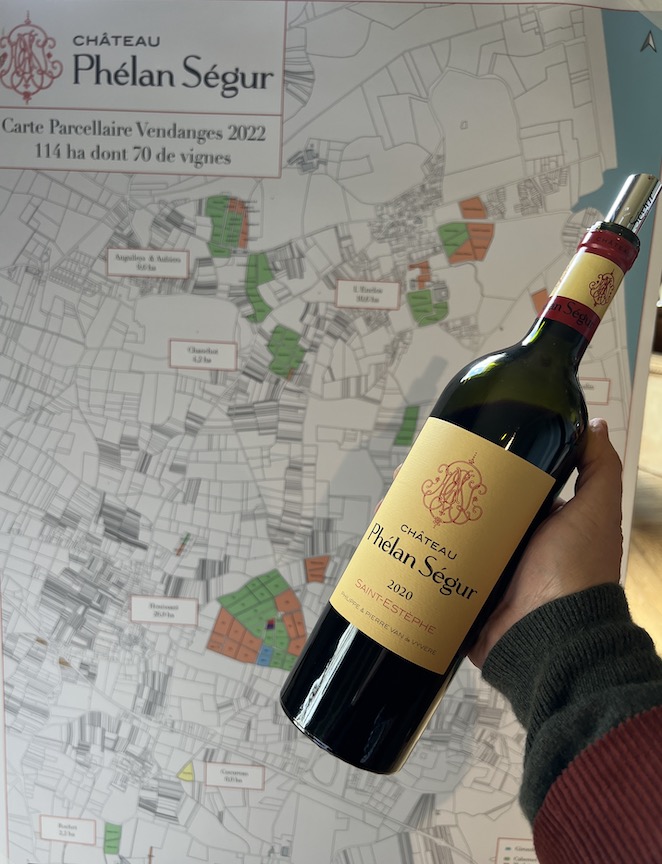
2020 marked the first year that this estate began using (and verifying) indigenous yeasts for fermentation for each vine parcel (see map in background).
Château Phélan Ségur – Tasted three times with similar results. You get the sense of the 2020 vintage here, a lower alcohol balance (13.5%) as opposed to the 14+% of the more crowd pleasing (and excellent) 2018. Sheer classiness of floral notes and purity of fruit leads to a long finish with lift. Very much in the same vein as 2016. A smooth Havanna cigar, with pencil lead coming from the Cabernets (54% Cabernet Sauvignon, 42% Merlot, 2% Cabernet Franc und 2% Petit Verdot), but also rich and suave on the mid palate. This estate has been on a roll, and here yet another fine wine. 95
Château Tronquoy Lalande – An excellent blend of 52% Cabernet Sauvignon, 42% Merlot and 6% Petit Verdot, with depth and especially a pleasing fresh, marked by iodine (oyster shell) aspects that appeal. I prefer this to the comparatively heavier 2019, which I had tasted in the winter of 2023. Again, more classical, with 13.5% alcohol. Estate staff made comparisons to the 2016 here. “Even the 2019 has a bit higher alcohol balance”, it was said. About 30 hectoliters per hectare. 93
Château Tour de Pez (Cru Bourgeois) – While austere, the wine is not rustic. More “Old School” and that is not a bad thing. Give it time. Good length. 90
Saint Julien
Château Beychevelle (Cru Classé) – Blending 51% Cabernet Sauvignon, 45% Merlot and 4% Petit Verdot, this wine shows off toasty oak derived notes with ripe fruit in a full bodied and smoothly tannic expression. There is spice and succulence, and the wine could be almost swanky in expression: but notable structure, albeit with some headiness, reassures. Tasted again in Washington D.C. in May, and it seemed a bit calmer in expression but similar. Clocks in at 13.7% alcohol. 94
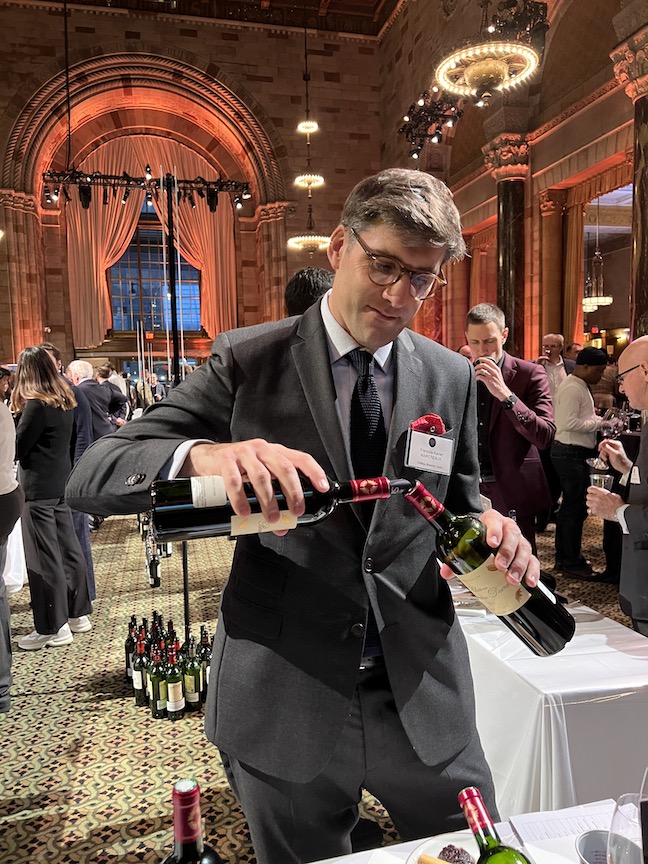
François-Xavier Maroteaux of Château Branaire Ducru preparing another bottle in New York.
Château Branaire Ducru (Cru Classé) – A wonderully refined wine, blending 58% Cabernet Sauvignon, 32% Merlot, 7% Petit Verdot and 3% Cabernet Franc. What I like is its charming elegance, indeed very Saint Julien! One gets the black currant from the Cabs, but also fresh dill and cool blueberry fruit, along with some blackberry and hints of menthol freshness, rather like a fresh meadow after rainfall. Bravo to the Maroteaux family. 94+
Château Langoa Barton (Cru Classé) – Tasted after both Beychevelle and Branaire Ducru in New York, I get a sense of more tannic grip in a more closed wine, but when tasted in Bordeaux late last year, this blend of 53.5% Cabernet Sauvignon, 38% Merlot and 8.5% Cabernet Franc, at about 13.5% alcohol, showed more opulence when compared to the Léoville Barton, with the Merlot showing a creamier touch than it did in January. 94
Château Gloria – This blend of 50% Cabernet Sauvignon, 34% Merlot, 4% Cabernet Franc and 11% Petit Verdot, having aged 14 months in 40% new oak is a great success for the price, and I look forward to trying their 2022. At 13.3% alcohol, the wine has depth and power, but is especially quite charming overall, and I can see how it will appeal to (many) consumers, also for the economical pricing. 94+
Château Gruaud Larose (Cru Classé)* – Refined pencil lead, floral, very dense yet smooth and palate filling in an elegant way. In short, a beautiful wine worthy of a First Growth. The overall impression from this blend of 79% Cabernet Sauvignon, 17% Merlot and 4% Cabernet Franc is effortless grace. The 95% new oak used to age the wine for some 18 months is very well integrated. Excellent balance between the 13.15% alcohol and acidity. Just one third of the harvest was used for the first wine, but the plan is to have a higher percentage in the future, as replanting works out over time. 98
Château Lagrange (Cru Classé) – I love the cool blueberry fruit aspect to this wine, which resembles in that sense the Grand Puy Lacoste, tasted just before in Washington D.C. in May 2023, but not the power of the Pauillac. Indeed, we are in Saint Julien here, no mistaking, and this estate continues to impress for quality and price. The blend in this vintage of 65% Cabernet Sauvignon, 24% Merlot and 2% Petit Verdot has a refined classiness to the palate with Cabernet driven pencil lead and a floral elegance that marks the long finish, with unmistakable mid palate juiciness. Bravo! 95
Château Léoville Barton (Cru Classé) – Powerful and deep, this famous estate stood out from many wines at the UGCB tasting in New York. As said above, it clocks in at 13.5% alcohol, lower than both 2019 and 2018, each with 14%. With the greatest percentage of Cabernet Sauvignon, at 85.5% (the 2019 has 84% and the 2018 82%), the 2020 exudes impressive notes of pencil lead and graphite, in a precise palate with underlying power. In many ways, quite a “classic” expression in the positive sense of the word. Long-term keeper, to open as late as 2060, for kids, or grandkids. 97
Château Léoville Poyferré (Cru Classé) – Blending 64% Cabernet Sauvignon, 31% Merlot, 3% Cabernet Franc and 2% Petit Verdot, the lovely engraved bottle celebrates 100 years of Cuvelier family ownership, with specific vineyard plot illustrations to reflect plot-by-plot selections and fermentation. And indeed, the wine is precise while showing excellent density. Tasted alongside the Barton in New York, the telltale sheen of Poyferré is highlighted and it works. Hard not to resist young, at first, but the finish shows quite a bit of tannin, resembling more a power driven Pauillac. Tasted again in Washington D.C. in May this year, and it was showing again beautifully, perhaps even better. Give it 10 more years for a proper opening drinking window: indeed, a great wine in the making. 97
Château Saint Pierre (Cru Classé) – A brisk attack brings forth a stylish and rather refined palate, marked by cool tobacco leaf and blueberry fruit. Quite a successful Saint Pierre, reflecting the classicism of the vintage, although some tannins seem a bit too forceful. Give it time… Blending 79% Cabernet Sauvignon, 15% Merlot and 6% Cabernet Franc, the wine aged 14 months in 50% new oak, clocking in at 13.3% alcohol. 93+
Saint Emilion
Château Beauséjour Duffau-Lagarrosse Premier Grand Cru Classé – This blend of 81% Merlot and the rest Cabernet Franc exudes finesse, cool fruit and especially limestone freshness. And even if the tannin seems a tad hard on the finish (Château Larcis Ducasse for example seems smoother), what pleases me is the almost Burgundian aspect, something very terroir-driven that fascinates. I would buy three bottles and see how the wine develops in next 10 years or so. 96
Château Berliquet – Tasted this blend of 69% Merlot and 31% Cabernet Franc twice with consistent notes. One needs time to coax its charms but let that sit in your glass and you get blood red orange and pomegranate, quite a bright expression, with tonicity and depth, the 14.5% alcohol balanced by acidity and verve. Aged 16 months in 50% new oak. This is a very fine estate that is going places since Chanel acquired it three years ago. 93
Château Canon Premier Grand Cru Classé* – Tasters at the UGCB tasting in New York marveled over how amazing this estate was from bottle. Phil Bernstein of MacArthur Beverages called it “the best”. Having assessed this blend of 68% Merlot and 32% Cabernet Franc three times with consistent notes, the wine is juicy and pristine in its expression of wet stone. The bright dark and ripe fruit (blackberry, red cherry) lead to a finish marked by vivid violet flower. Great purity, density and concentration on the broad and long finish, with salinity and limestone freshness – as ever the pH is low at 3.53. Alcohol is 14.5% and the wine was aged 18 months in 50% new barrels. I bought a case en primeur and am (very) happy that I did so. 98
Special mention for the second wine Croix Canon, even if the tannins seem a touch raw by comparison. There is bright fruit, with plum and intriguing peaty aspects leading to a finish marked by fresh clementine. The wine is a blend of 65% Merlot and 35% Cabernet Franc. Aged 18 months in 30% new oak.
Château Cheval Blanc* – In a somewhat closed phase when tasting it at the negociant Joanne, time in glass coaxed layers of ripe fruit with sweet spice and violet. The palate texture and remarkable tannic structure impresses most at this early stage. The 65% Merlot in the blend lends layers of ripe fruit but also structure. The minty freshness on the finish, at least partly provided by the 30% Cabernet Franc (and 5% Cabernet Sauvignon completes the blend), is endless. The wine communicates a classicism with gravitas leaving the impression of a full bodied palate of poise and refinement. 99
Petit Cheval of Cheval Blanc – Sheer pleasure to drink, because of the utter red fruit charm is explained by the 59% Cabernet Franc, which gives off crunchy red fruit and perfume, as the 41% Merlot lends opulence. At 14.5% alcohol, what balance! The very suave tannins reveal wet stone. “Seriously good”, remarked Jane Anson. Agreed! Seamless. One does not talk about alcohol or tannin or acidity. While one negociant I heard bought this wine for €100, the first wine Château Laroque, is also excellent wine, at just €15, so price puts matters into perspective, and yet … this gets my nod for Second Wine of 2020. 95
Clos Fourtet Premier Grand Cru Classé* – This blend of 90% Merlot, 7% Cabernet Sauvignon and 3% Cabernet Franc totally wowed me in New York, for its sheer balancing act between vivid juicy ripe blackberry and plum and serenely seashell freshness, culled from that magnificent limestone plateau. Reflecting great terroir, the 14.5% alcohol is balanced by vivacity (pH 3.6). With judicious 50% new oak for aging, you end up with a long, memorable finish. 97+
Château de Ferrand Grand Cru Classé – This blend of Merlot (74%), Cabernet Franc (25%) and Cabernet Sauvignon (1%) exudes freshness and balance, with smooth tannin. With floral and fruit aromas and flavors, excellent oak integration leading to a finish with minty lift. For about €25 a bottle, you can do far worse. 93+
Château Fleur Cardinale Grand Cru Classé – This blend of 77% Merlot, 18% Cabernet Franc and 5% Cabernet Sauvignon, with just under 14.5% alcohol and a low pH of 3.57 is very smooth and even spherical in expression. I have noticed increasing polish in the wines from this estate and I like the tannic edge from the 2020. 94+
Château Larcis Ducasse Premier Grand Cru Classé* – Clocking in at 14.5% alcohol, this wine incarnates elegance and refinement, so nicely balanced (and smooth) and with wet stone minerality across the board, as if enveloping the evidently ripe (not overripe) bright red and dark fruits. The finish is very long, and exciting. Buy this with confidence! 97
Château Laroque Grand Cru Classé – An amazing deal. For under €25 (about $36 in the U.S.), pure ripe fruit, seafaring freshness and wet stone with elegance and refinement. It is nearly 100% Merlot, save for 1% Cabernet Franc, having aged in 50% new oak. The 14.5% alcohol is nicely balanced by the acidity. “A brilliant wine”, remarked Jane Anson. Yes. 95+
Château Pavie Macquin Premier Grand Cru Classé – What juicy black cherry, what brightness and what engaging opulence in this blend of 80% Merlot and 20% Cabernet Franc! Espresso notes and ripe fruit in a delectable sap-driven mid palate lead to a smooth, lingering finish. 96
Château Rochebelle Grand Cru Classé – A gorgeous wine, so balanced as broad yet chiseled. Bright fruit expressions. While the tannins are velvety smooth, they make themselves present to highlight much underlying power. Readers should not that in the latest classification, this estate all but made it to the Premier grade: it fulfilled the tasting requirement, work in the vineyard and vinification, but only lacks notoriety, including a lack of being shown in a film. Very important, that one. 95
Graves/Pessac-Léognan
Domaine de Chevalier – At least one estate last that transcends the vintage, again taking advantage of a cooler microclimate. This blend of 55% Cabernet Sauvignon, 35% Merlot and five percent each of Cabernet Franc and Petit Verdot has blueberry coolness with refined tannin. It has a plump, ripe plum and blackberry mid palate reflecting ripeness, and plenty of rather minty freshness on the finish. A lovely wine! 95
Château Haut Bailly – A splendid wine, that also rises above the vintage.
Château Malartic Lagraviere – Another estate posting some 14% alcohol, but unlike some others that seemed heavy handed, an excellent balance between the richness of the vintage and structure and freshness. Nice job! 94
Château La Mission Haut Brion – At 14.7% alcohol, a big wine but keeps you salivating, with notes of exquisite brownie cake and plum. The blend – as has been the case in recent years – is dominated by Merlot, with nearly 49%, along with just over 42% Cabernet Sauvignon and about 8% Cabernet Franc. As one may expect, a powerful wine, exuding appealing sweetness and roasted fruit. I like it more than the Haut Brion, which seemed a bit heavier and monolithic, especially compared to fellow First Growths Château Margaux and Mouton. But let’s taste again if we get a chance in about 10 years, because Haut Brion has a tendency to surprise you with time! 97
Château Rahoul – For the money, it is hard to do better than this succulent, unpretentious red Graves, clocking in at 13.5% alcohol. A majority of Merlot is suave and lush without being overripe, with structural backing from Cabernet Sauvignon and a spicy smidgeon of Petit Verdot. You get a sense of crushed mint and tobacco. Keeping in mind restaurant lists, if you see the 2020, get it! 92+
Dry Whites
Some came across dangerously close to being canoe wines – close to water. Others seem to have a bit too much alcohol for my sense of balance. But here some preferences.
Clos des Lunes Lune d’Argent – Want a tasty and affordable white? Look no further than this 70% Semillon blend Bordeaux. Freshness, opulence, refined texture. Break out the scallops. Nice job! 13.5% alcohol. 92
Fourcas Hosten Vin Biologique – With 15% alcohol on the back label, this blend of 67% Sauvignon Blanc, 18% Sauvignon Gris and the rest Sémillon is a mouthful of wine sure to please people at wine bars, if not the most subtle. A lot of fun to drink, but maybe not the entire bottle in one go. 90
Château Chantegrive Cuvee Caroline – Quite the nuanced white. Preferable to the Fourcas Hosten white tasted just before, because I prefer the lower alcohol balance (13%). Get me the linguini with clams, because not dry and crisp enough for oysters. A blend of 60% Sauvignon Blanc and 40% Sémillon. 92
Château Brown – Almost yellow color, 14% alcohol, this blend of 80% Sauvignon Blanc and the rest Semillon comes across obviously rich, and that is the purpose. It lacks subtle refinement I encountered in wines like the Cuvée Caroline, but would please aplenty as a wine bar selection for people who want “big” whites, and why not? 90
Château La Garde – This 100% Sauvignon Blanc, clocking in at 12.5% alcohol boasts a rather light color and comes across as rather fresh for the vintage. I can see this pairing well with oysters on a half shell. 91
Château Bouscaut – A wine combining verve with palate presence, dominated by Sauvignon Blanc (nearly 70%) and clocking in at 13.5% alcohol, the palate shows some thickness but also exudes brightness. Try with seared scallops. 92
Château Carbonnieux – I really like this blend of 65% Sauvignon Blanc and 35% Semillon, clocking in at 13% alcohol, as it exudes much mid palate excitement: Lemon and lime, with some quince and hints of tropical but only suggested, and balanced by acidity. Very nice job! 94
Château Malartic Lagravière – A blend of 72% Sauvignon Blanc and 28% Semillon, clocking in at 14%, this comes across rather polished with nuance, even if it is not my favorite among the 2020s. 93
Domaine de Chevalier – Tasted twice with better results in New York. This is rather yellow as a color. Not sure if representative sample. But I like the pure Key Lime Pie and lime aspects to the wine. 94
Château Pape Clément – This has energy and briskness to match the evident ripeness and opulence, so a very nice job at 13% alcohol, this blend accounting for two-thirds Sauvignon Blanc is pretty darn good! 94
Category: Blog Tagged: 2020, Bordeaux, Calon Segur, Langoa Barton, Léoville Barton, Margaux, Montrose, Moulis, Mouton Rothschild, Pauillac, Pessac-Léognan, Phelan Segur, Pomerol, Saint Emilion, Saint Estephe, Saint Julien
 Wine Chronicles
Wine Chronicles
Share This